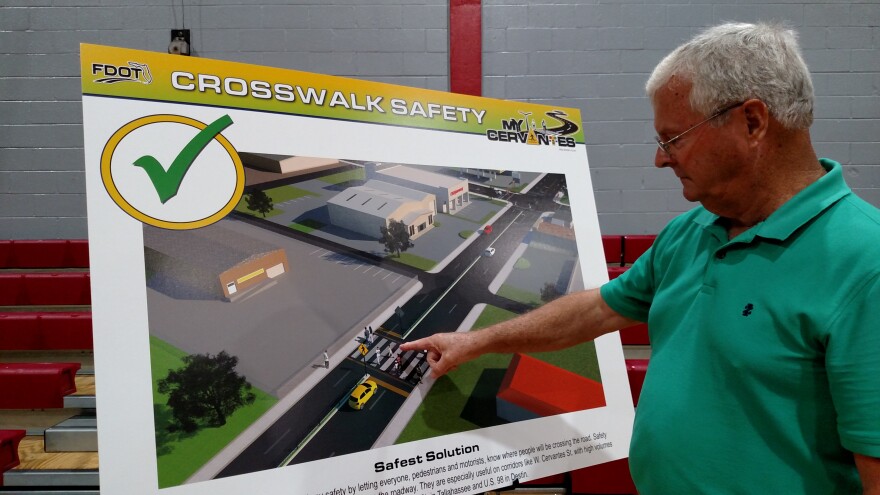Earlier this week, Pensacola area residents got a second chance to review and comment on Florida Department of Transportation plans to improve pedestrian safety on Cervantes Street. Most aspects of the road safety project are getting thumbs up. But, at least one proposed feature is drawing some push back.
The busy intersection at the corner of E Street is included in the West Cervantes Pedestrian Safety Improvement Project, which is a $7.5 million state and local effort to install a series of safety enhancements along a 2.3-mile segment of the four-lane roadway from A Street westward to Dominguez Street.

Already, there are new pedestrian crossing signs, radar speed-control signs alerting motorists to slow down, and enhanced LED lighting has been installed along the corridor.
This location also has one of eight push-button signal controlled crosswalks either existing or planned for significant intersections on the road.
Just one block north is the Fricker Community Center, where the FDOT hosted a public workshop on the proposed safety plan.
“The plan is good and everything, but putting the barriers in and they’ll have to go all the way around the corner just to get there; no,” said Constance Knight, who took the short walk from her home at nearby Attucks Court to take a look at plans for the roadway.
Knight is opposed to a planned fence-like barrier along a new center median that would restrict left turns for vehicles and force pedestrians to use crosswalks.
“They need to sit and observe from the perspective of tenants going across the street from “F” to the other side to the Citgo station and back and forth, back and forth,” Knight said of plans to close off the crossing there.
“Nobody’s going to walk that far to the red light. You got older people who cross that street, too, that come down from the neighborhood to that store, and vice versa. So, we’re going to see how that plays out.”
This is Knight’s position despite the fact that there were 32 crashes involving pedestrians or bicyclists over a four-and-a-half year period from January 2014 to June 2018 and she’s known some of the crash victims.

"Yeah, one lady got hit by a car; I knew her very well. And, then I knew the young lady that got hit up on M and Cervantes,” she says of the June 28, 2018 wreck where 8-month old Neariaah Williams and 28-year-old Nephateria Willians were killed by a hit and run driver going over 90 mph.
“Yes, I had just seen her (Nephateria Williams). Cervantes Street has always been a bad street.”
Inside the Fricker Center gymnasium, dozens of people stopped by the Fricker Center to look at the plans and meet informally with project engineers, including Brownsville area business owner Cliff Fields. Like Knight, he’s opposed to the planned median barrier.
“The way they have the fence going down where you can’t turn on the streets,” said Fields. “From a business standpoint, it’s going to be really detrimental.”
Fields is owner and operator of Cliff Fields Motors on Mobile Highway at the western end of the corridor. He’s worried about the unintended impact of the proposed traffic diversion on the Brownsville community, which is undergoing a bit of a revival amid long-time struggles with prostitution and drug crime.

“If the businesses don’t make it, then we’ll be handing the neighborhood over to the wrong folks, and it won’t make an economic comeback,” predicted Fields, as he referenced the efforts of the Brownsville Community Redevelopment Plan to attract new businesses to neighborhood.
“Fencing off where people can’t turn into your business, there’ll be nobody spending new investment money when 50 percent of their customers can’t get to them without going up three blocks, turning around a block and coming back.”
Images of the barriers and other proposed features such as mid-block crosswalks, push-button activated pedestrian crosswalks, reduction in lane width from 12 feet to 10 feet, and landscape options were among numerous large poster boards displayed throughout the gym.
Additionally, there was a huge laminated map of the project area laying across a couple of long tables.
“You and I are right here. There are one, two three; six frowny faces there, one frowny face here, one frowny face there, two frowny faces there,” said Pensacola Mayor Grover Robinson as he points to the map around the intersection at “F” and Cervantes, one of the areas where the grid would be blocked.
“We’re going to try to press for every opening that we can,” declared the mayor. “We get it though. At some point we’re not going to be able to have every cross street (open) because there is going to be a need to protect safety and again, we’re trying to strike that balance.”

According to DOT spokesperson Ian Satter, even without the pedestrian barriers, the current plan includes the addition of raised medians, which still would restrict left turns. The benefit is a reduced number of conflict points, which should reduce the amount of crashes on the roadway, which is the point of the improvement project.
However, Satter reiterated that the project is still in the design phase and subject to change, based on public feedback.
“So, we want to make sure that we’re providing the best product we can and safest product we can, but at the same time listening to them and understanding their concerns so we make adjustments to our designs,” Satter said. “Not everything we design is perfect. We know that. So, we want to make sure that folks can come in with their concerns and comments and from our last meeting, we took some of those and implemented them into what you’re seeing today.”
There’s still time for residents to weigh in. The deadline for written comment is Tuesday, August 27 and a formal public hearing will be scheduled for this fall.
Construction on the $7.5 million project is expected to begin in the fall 2020. Find a link to the safety plan, by visiting the project page on the Florida Department of Transportation's website.







